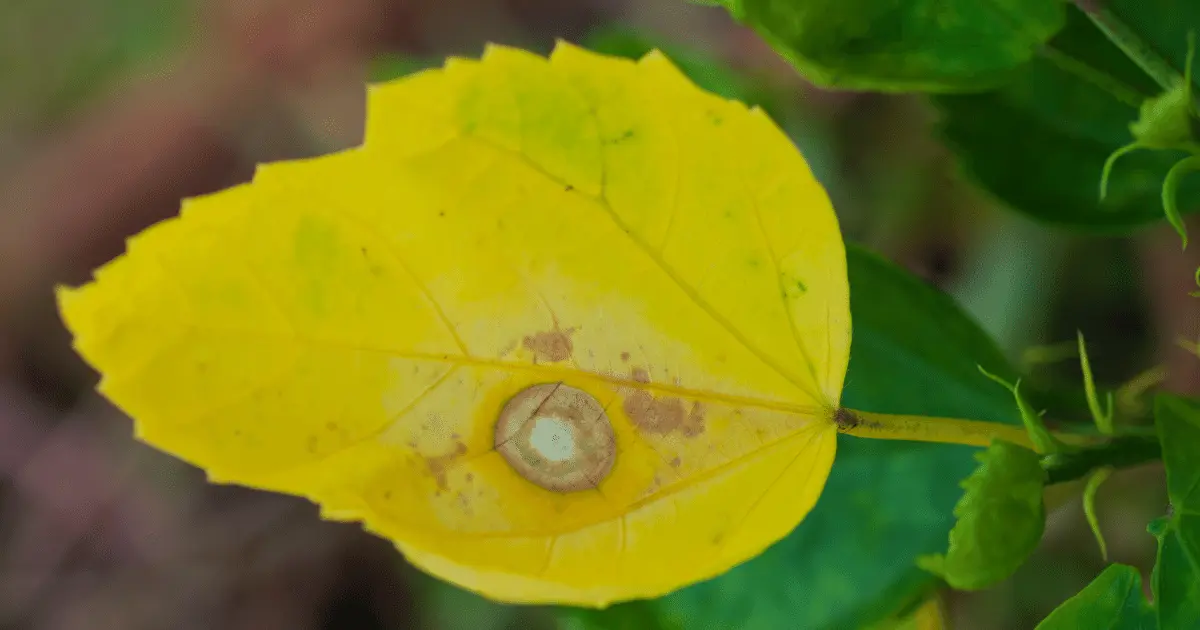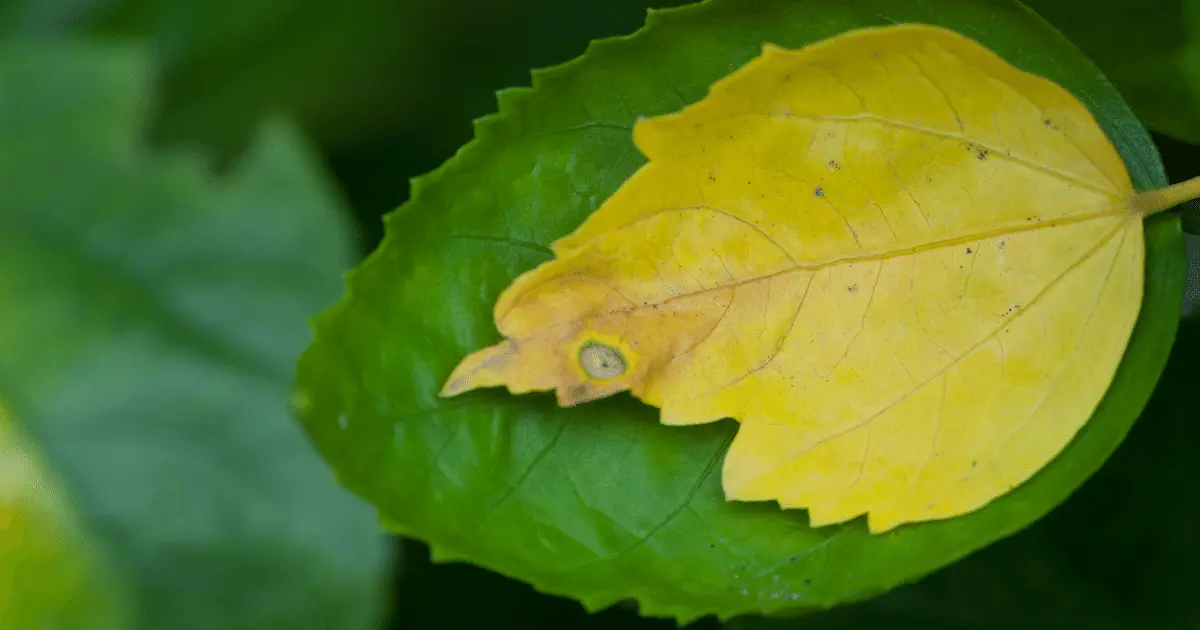The yellowing leaf is a common problem in hibiscus plants. Improper care of the plant can cause the leaves to turn yellow as well as wilt and die.
The hibiscus leaves turning yellow is a cry for help signals for specific needs. Sometimes, the yellowing leaves correct themselves and turn back to their green color, while sometimes, the whole plant needs to be pruned.
Why do Hibiscus Leaves Turn Yellow?

The hibiscus plant is a genus of flowering plants that belong to the mellow family. There are over 200 species of this plant, with each varying in size and color.
A healthy hibiscus plant has green leaves and beautiful flowers on it. Hibiscus leaves turn yellow when proper care is not given or during temperature changes.
Your hibiscus leaves may have turned yellow due to stress, nutrient deficiency, over-watering, and even under-watering.
Causes and Treatment of Yellow Leaves in Hibiscus Plants

There are several factors behind the hibiscus leaf yellowing. Knowing these factors and how to spot them helps you fix the issue before it becomes a problem.
Nutrient Deficiency
If your hibiscus leaves are turning pale yellow and not falling off, it suffers from a nutrient deficiency. This deficiency can be corrected by applying fertilizer or Epsom salts to the soil or amending the soil.
Hibiscus plants require an adequate amount of nutrients to stay healthy. When underfed, they show signs of stress, with the most noticeable being a lack of flowers and yellow leaves.
When applying fertilizer, you must be careful not to over-fertilize the plants, as too much of it will stimulate foliage growth at the expense of flowers. It is best to apply fertilizers formulated specifically for hibiscus plants to get a balance in Nitrogen, Phosphorus, and Potassium(NPK)
Treatment: Fertilize or amend the soil.
Light
Hibiscus plants thrive and attain their full potential under the sun. Yellowing leaves can also be caused by a lack of sunlight. However, too much light can also cause the plant’s leaves to turn yellow.
Lack of sunlight
When hibiscus plants do not receive enough sunlight, their leaves begin to turn yellow and eventually fall off; there are also fewer flower blooms and stunted growth.
Too little exposure to sunlight prevents the plant from producing enough chlorophyll to keep the leaves green.
Treatment: Cut off the yellow leaves and move your potted hibiscus to an area more exposed to sunlight. Your hibiscus is set to recover from its yellow appearance under sunlight.
For established hibiscus plants, clear out any vegetation or tree limbs that cast shade over the plant to allow more light.
An abundance of Sunlight
If your hibiscus plant is exposed to too much sunlight, the leaves begin to sunburn, causing yellow leaves to appear as well as white spots on the foliage.
Treatment: Cut off the damaged leaves and move the hibiscus plant to a location with less sun exposure where it can get partial shade during the hottest hours of the day.
If the hibiscus is not planted in a pot, you should have it transplanted to a location with more shade.
Watering
Just like every plant, the hibiscus plant requires water to survive. However, too much water and too little water can cause the plants to leave to turn yellow and eventually die.
Under-watering
Under-watering occurs most times in hibiscuses when it is not consistently watered and also if the oot lacks good drainage. The leaves asides turn yellow and become thin and droopy.
The soil on which your hibiscus is planted should be constantly moist to prevent the leaves from turning yellow. The amount of water required depends on how quickly the soil dries out. Established hibiscus plants planted in soil that retains moisture should not be watered too often.
Treatment: Water the plant once a week. Use a spray bottle on the leaves to increase the humidity and prevent water loss. For plants established outdoors, apply mulch to dry areas.
Over-watering
Hibiscus leaves can also turn yellow from over-watering. As a result of a lot of stress from over-watering, the plant’s roots began to rot from too much water around the roots.
Over-watering can mean several things. It could mean you are putting in too much water at a time or putting in the appropriate amount of water but too frequently.
Treatment: You need to ensure that you have good drainage for your pot if you are using one to prevent water from not draining properly
To know when to water your plant, stick your finger in the top of the soil. If it feels dry, then you need to water it.
Temperature Change
Too much heat and too much cold can cause hibiscus leaves to turn yellow, as well as changes in humidity level. There are two species of the hibiscus plant commonly grown.
The tropical hibiscus and the hardy hibiscus. As the name implies, the tropical hibiscus thrives under sunlight and is sensitive to cold. Conversely, the hardy hibiscus can tolerate cold weather and thrive in a wider variety of climates.
The leaves on the tropical hibiscus can turn yellow if there is a sudden drop in temperature. Tropical hibiscuses cannot tolerate cold. It is very important to grow species of hibiscuses that is well suited for your climate to avoid yellow leaves.
The hardy hibiscus can tolerate cold but should also be grown in areas where it is also exposed to sunlight.
Treatment: if your leaves turn yellow after being exposed to cold, move the plant to a place with warmer conditions to recover.
Pests
An unhealthy hibiscus plant is prone to pest infestation. The healthier your plant is, the more resilient it is to pests. A plant that lacks adequate light and lacks nutrients is more vulnerable to pests and the diseases that come with them.
Hibiscus plants are prone to infestation by Insects like aphids, mealy bugs, and spider mites. However, the spider mite is the most likely suspect for yellow leaves on plants.
When infested with spider mites, the hibiscus leaf begins to develop pin-sized yellow spots, leaves drop, and there are fewer flower blooms.
Treatment: if you suspect spider mites or other pest infestation, spray the plant with soapy water or mild pesticide. Be careful not to overspray the pesticide, as this may cause more discoloration of the leaves.
